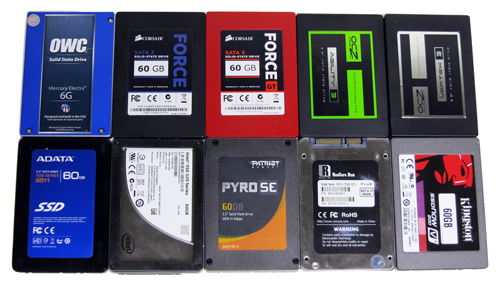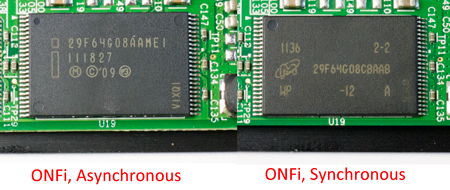Ten 60 GB SandForce-Based Boot Drives, Rounded-Up
The Great 60 GB SandForce SSD Round-Up
Hardly a month goes by that we don't see another SSD launch into an already-crowded market. Most of the time, the introduction centers around a SandForce controller, and there's a good reason for that. The company's technology is fast. It's also designed to work alongside lower-quality flash memory, if need be, driving down the costs of SSDs at a time when price is the primary barrier keeping enthusiasts from adopting solid-state storage.
More than one year has passed since the controller company launched its line-up of second-generation logic, and its solutions are still at the top of their game. OCZ was the first vendor with a SandForce-based desktop-oriented drive way back then. And within the last 30 days, Intel even threw its hat into the ring with its SSD 520, built on top of the very same controller, but complemented with the company's own cherry-picked NAND. Truly, SandForce deserves kudos for remaining a relevant force, even in the face of newer controllers from competing sources.
Although the vendors selling drives centering on SandForce's hardware often sit at the top of our benchmark charts, there are, admittedly, a lot of them. On one hand, that's a good thing. Competition between many similar products pushes prices down as low as they can possibly go. But as you see in the picture below, consisting of only 60 GB SSDs, the number of choices can quickly get overwhelming.
Are all of those drives exactly the same? Decidedly not. Although each SSD employs the same controller and boasts the same capacity, there is a limited number of knobs and dials that vendors can tweak to affect pricing and performance. And that's the idea behind today's round-up. We want to explore how one SandForce-based drive differs from the next, and hopefully end up with a better idea of the 60 GB drive you'd want to boot from in your next PC.
On deck, we have:
- Adata S511 60 GB
- Corsair Force 3 60 GB
- Corsair Force GT 60 GB
- Kingston SSDNow V200+ 60 GB
- Intel SSD 520 60 GB
- OCZ Agility 3 60 GB
- OCZ Vertex 3 60 GB
- OWC Mercury Electra 6G 60 GB
- Patriot Pyro SE 60 GB
- RunCore Pro V 60 GB
As we dig into these 10 SSDs, know that there is a performance hierarchy distinguishing drives based on SandForce's controller hardware. Generally, two SF-22xx-based SSDs of a given capacity perform almost identically, provided that they both employ the same NAND interface. Vendors do use different NAND, though, and that's why there is variation between drives centering on the same controller hardware.
Second-gen SandForce SSDs are available with different flavors of memory, and this is their order of performance, from highest to lowest.
Get Tom's Hardware's best news and in-depth reviews, straight to your inbox.
- SandForce controller with Toggle DDR NAND (Mushkin Chronos Deluxe, Patriot Wildfire, OCZ Vertex 3 Max IOPS)
- SandForce controller with Synchronous ONFi NAND (OCZ Vertex 3, Corsair Force GT, Kingston HyperX)
- SandForce controller with Asynchronous ONFi NAND (OCZ Agility 3, Corsair Force 3, Mushkin Chronos, Patriot Pyro)
Right off the bat, we're able to sort our round-up into two groups: one that employs synchronous memory for better performance, and the other that uses asynchronous flash in order to save money.
| Synchronous | Asynchronous |
|---|---|
| Adata S511 60 GB | Corsair Force 3 60 GB |
| Corsair Force GT 60 GB | Kingston SSDNow V200+ 60 GB |
| Intel SSD 520 60 GB | OCZ Agility 3 60 GB |
| OCZ Vertex 3 60 GB | OWC Mercury Electra 6G 60 GB |
| Patriot Pyro SE 60 GB | Row 4 - Cell 1 |
| RunCore Pro V 60 GB | Row 5 - Cell 1 |
How significant is the difference between the various memory interfaces? From there, can we distinguish between the drives in one group or the other? We’ll let the benchmarks do the talking.
Current page: The Great 60 GB SandForce SSD Round-Up
Next Page Test Setup And Firmware Notes-
mayankleoboy1 As these drives are basically boot drives, i would have liked a test where you measure the total time taken to install a fresh wi7-sp1 on it and install updates and install a few softwares likeReply
Ms-Office
Adobe pdf reader
a web browser, a photo manipulating program
a music/video player.
Install a game from a ISO.
An antivirus
And all these apps should be installed from the SSD itself (meaning their setups should be on the SSD).Then you should test the startup and shutdown times.
All these synthetic benchies dont make much sense, IMHO.
-
mayankleoboy1 I have found that when working with SSD's, single core CPU performance becomes a big bottleneck in some tasks.Reply
A lot of operations use only a single core and the SSD cant use its true potential. That is, the CPU cant process data as fast as the SSD can provide.
This is just reverse of what happens in case of mechanical HDD's. -
acku http://www.tomshardware.com/reviews/ssd-520-sandforce-review-benchmark,3124-14.htmlReply
You're not going to see a major difference. -
phamhlam mayankleoboy1I have found that when working with SSD's, single core CPU performance becomes a big bottleneck in some tasks.A lot of operations use only a single core and the SSD cant use its true potential. That is, the CPU cant process data as fast as the SSD can provide.This is just reverse of what happens in case of mechanical HDD's.Reply
Well, it is pointless though since everything you are doing is so fast that it doesn't matter anymore. I however see your point since I can be loading a program and my SSD is not even at max speed my CPU frequency is maxed out. The only way to get more speed is to just overclock as much as you can. -
mayankleoboy1 ackuhttp://www.tomshardware.com/review 24-14.htmlYou're not going to see a major difference.Reply
that is the point of buying a cheaper SSD based on a chepaer NAND.
-
compton Considering the conclusion that performance is defined by flash, I find it interesting that the one SF2281 with Toggle NAND at 60GB is not in the roundup (in North America anyway). The Mushkin Chronos Deluxe 60 is substantially cheaper now at $99. It's performance characteristics are much more profound than the 25nm ONFI sync/async models. They're often out of stock at Newegg, and for good reason.Reply
-
clownbaby Is there a benchmark to compare virtual memory performance? My current workstation has 24gb of memory, which means Windows eats up 36gb of my boot drive for virtual memory. (yes, I know I can change/disable it, but some programs act wonky when it's screwed with). A dedicated virtual memory drive would free up space on my primary ssd, as well as keep the writes down.Reply
I'd also like to see small drives benchmarked as swap drives in video editing machines. Currently I'm using a raid 0 array of 1tb samsung drives that keeps up well enough, but I'd be interested to see if there are tangible productivity differences. -
JackNaylorPE With a final page heading "Performance Is Defined By Flash" I would have like to see that difference looked at more closely. For example, the Mushkin Chronos Deluxe uses premium 3Xnm Toshiba Toggle Mode Flash (as does Patriot Wildfire, Vertex 3 Max IOPS and OWC Mercury Extreme Pro) and I would love to see for example how just changing the Flashin in an SSD from the same manufacturer and line (i.e Chronos standard versus Deluxe, Vertex 3 versus Vertex 3 Max IOPS). With that info, a user can decide whether it's makes sense to invest in say the premium Toshiba stuff as compared to the "same SSD w/o the premium Flash. That was what I expected to see when I read the referenced page heading.Reply -
jsowoc I'm wondering why Toms' own trace-based benchmark didn't make it into this round-up? Does it take much longer to run than the other tests? While comparing synthetics is important to determine why a certain drive behaves a certain way, trace-based benchmarks (PCMark 7 could be considered trace-based) is what makes the final purchasing decision. In this case, PCMark was the one with the most clear-cut differences, ones that would likely be mirrored in a trace-based benchmark.Reply
For a future SSD review/roundup could you take, for example, 10 real-life traces from 10 different editor's machines (the more variation in workload, the better), and then compare the %change in execution time vs. a reference drive?

